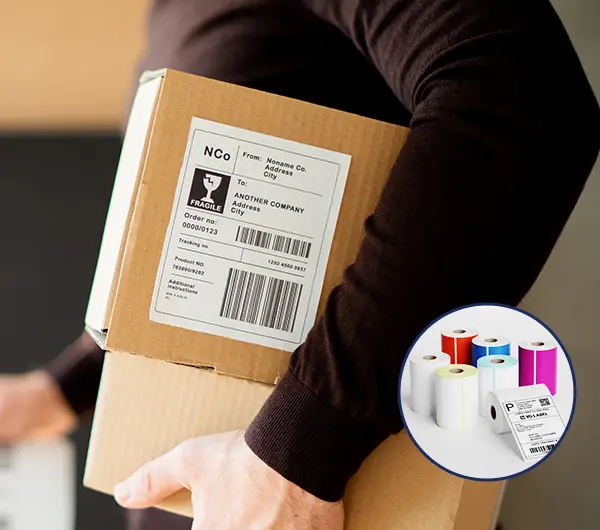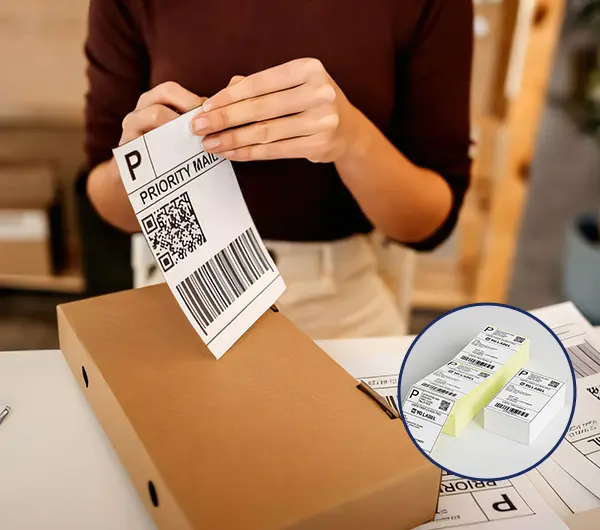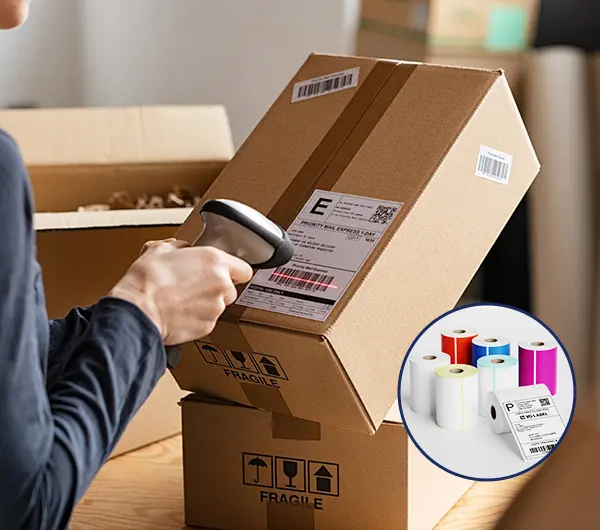What is a Thermal Label? A Comprehensive Guide to Direct Thermal Labels & Their Waterproof Performance


More Product Blog to View
Share to


Top Reading
Couldn’t Find the Product or Company Information You Need? Let’s Talk!
We know it’s not always easy to find the exact details you're looking for. If you can’t locate specific product or company information, just reach out — we’re ready to assist!
Contact Us Today
* You will be directed to contact us page
In the realms of warehousing, logistics, retail, and more, thermal labels have become an indispensable tool for efficient identification and information transmission. This blog will delve into what a thermal label is, whether thermal labels are waterproof, and the ins and outs of direct thermal labels, providing you with a thorough understanding of this essential product.
1. Introduction: Definition and Market Value of Thermal Labels
Thermal labels are a type of labeling material that forms images through thermal energy. They can print clear text, barcodes, and patterns without ink or ribbons, making them highly efficient and cost-effective, thus gaining rapid market penetration. Among them, direct thermal labels stand out as a typical representative of thermal technology, continuously breaking through in terms of waterproof, oil-proof, scratch-resistant, and other properties to meet the stringent requirements of various scenarios.
2. What is a Thermal Label?
2.1 Working Principle of Thermal Labels
The core of a thermal label lies in its thermochromic layer. When the heating elements of a thermal printer come into contact with the label material, the layer undergoes a chemical reaction due to temperature changes, presenting black text or patterns. This "consumable-free" printing method makes the production and use of thermal labels more efficient and environmentally friendly.
Thermal labels are mainly divided into two types: direct thermal and thermal transfer. Direct thermal labels rely entirely on the chemical reaction of the thermochromic layer for imaging, while thermal transfer requires the assistance of a ribbon. The direct thermal label, which we focus on in this article, has significant advantages in short-cycle and high-frequency identification scenarios due to its simpler process.
2.2 Material Composition of Thermal Labels
A high-quality thermal label typically consists of three layers:
- Base Layer: Provides structural support for the label, commonly including coated paper, synthetic paper, etc.
- Thermochromic Layer: The key to determining printing clarity and retention time. A high-performance layer must balance color development speed and stability.
- Adhesive Layer: Ensures the label can be firmly attached to cartons, packages, and product surfaces. A super-adhesive layer is one of the core guarantees for direct thermal labels to "not fall off easily".
3. In-Depth Analysis of the Waterproof Performance of Direct Thermal Labels
3.1 Are Thermal Labels Waterproof?
This is one of the most concerned questions for many users. In terms of material properties, high-quality direct thermal labels have excellent waterproof performance. As shown in the "Triple-Proof Shipping Label" in the image, through special coating treatment and substrate selection, they can maintain clear labels and stable adhesion in splashing water and humid environments.
The waterproof principle is mainly reflected in two points: first, the waterproof formula of the coating can effectively block water penetration and prevent pattern smudging; second, the moisture-proof design of the substrate, even in high-humidity environments, the label will not deform or fall off due to water absorption. For example, after immersing a direct thermal label in water, its barcode can still be recognized by scanning equipment, and the text clarity is hardly affected. Get free samples!!
3.2 "Triple Protection" of Direct Thermal Labels: Waterproof, Oil-Proof, and Scratch-Resistant
In addition to being waterproof, high-end direct thermal labels also have oil-proof and scratch-resistant properties. In logistics scenarios, packages may come into contact with oil stains; during warehouse sorting, labels may be scratched by tools, and direct thermal labels with "triple protection" can easily cope with these challenges.
Take the test scenarios in the image as an example: when the label is immersed in oil, its printed information does not fade or blur; when the label surface is scratched with a hard object, the barcode and text remain intact – this means that the information transmission reliability of direct thermal labels is extremely high in complex industrial environments.
4. Application Scenarios and Advantages of Direct Thermal Labels
4.1 Core Application Fields
Direct thermal labels, with their performance advantages, are widely used in:
- Warehousing and Logistics: Used for package waybills and inventory identification, compatible with mainstream printers such as Zebra GK420D and Zebra ZD4 Series, enabling efficient order printing and sorting.
- Retail and E-commerce: Product price tags and courier waybills (compatible with printers like Dymo LabelWriter Series) meet the high-frequency and fast-paced order generation needs.
- Medical and Food Industries: Due to compliance with FDA standards and being BPA&BPS Free (free of Bisphenol A and Bisphenol S), they can be used for drug labels and food traceability labels, ensuring health and safety.
- Manufacturing Industry: Process identification and equipment labels in the production process maintain stable performance in a wide temperature range of -15~65℃, adapting to the complex environment of the workshop.
4.2 Competitive Advantages of Direct Thermal Labels
- Cost Advantage: No ink or ribbon consumption, reducing long-term use costs.
- Efficiency Advantage: Fast printing speed, compatible with mainstream printers, and seamlessly integrated into automated production lines and warehousing systems.
- Performance Advantage: Waterproof, oil-proof, scratch-resistant, and clear printing, meeting the strict requirements of multiple scenarios.
- Environmental Advantage: BPA&BPS Free and RoHS compliant (free of harmful chemicals), in line with green production and consumption trends.
5. How to Choose High-Quality Direct Thermal Labels?
5.1 Focus on Core Parameters
- Size and Specifications: Popular sizes recommended in the image, such as 4"×6" (102×150mm) and 4"×3" (102×76mm), are compatible with most waybills and identification scenarios. Custom sizes are also supported to meet special needs.
- Material and Coating: Prioritize high-quality thermochromic coatings that are waterproof and scratch-resistant to ensure printing clarity and durability.
- Adhesion and Compatibility: Super-adhesive layers can firmly adhere to different material surfaces such as cartons, plastics, and metals, and they need to be compatible with mainstream printers like Zebra, Dymo, and Brother QL Series.
5.2 Verify Compliance and Certification
High-quality direct thermal labels must pass FDA certification (food contact safety) and RoHS certification (environmental protection without harmful substances), and clearly indicate "BPA&BPS Free". Especially in the medical and food fields, compliance is a key threshold for selection.
6. Conclusion: Future Trends of Direct Thermal Labels
With the continuous development of logistics automation and new retail, the market demand for direct thermal labels will continue to rise due to their high efficiency, low cost, and high performance. At the same time, consumers' requirements for product traceability and information transparency are also driving direct thermal labels to continuously iterate in terms of waterproof and oil-proof properties.
In the future, they will further break through in the direction of intelligence (such as integrating RFID chips) and customization (such as color thermal labels).
For enterprises, choosing a direct thermal label with strong waterproof performance and compatibility with mainstream printers can not only improve operational efficiency but also establish a competitive advantage in the supply chain and customer experience.
For ordinary users, understanding the nature of thermal labels and the waterproof performance of direct thermal labels can also make more informed choices in daily express delivery and item identification—Yongguan self-adhesive label manufacturer.
Reviews
Do you find this content helpful? Leave your review below!
Send
We use cookies and similar technologies on our website to enhance your browsing experience, analyze site traffic, and personalize content. By continuing to browse or by clicking "Accept All Cookies," you agree to our use of cookies.
Copyright © Shanghai Yongguan Adhesive Products Corp., Ltd. All Rights Reserved.












.webp)




